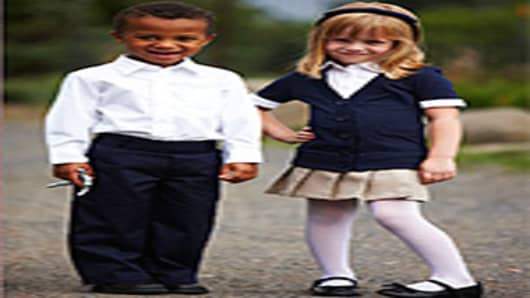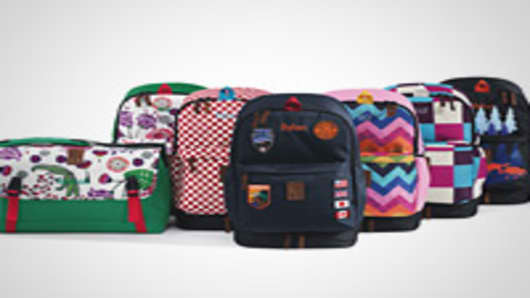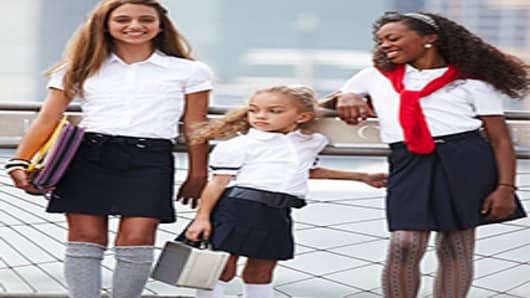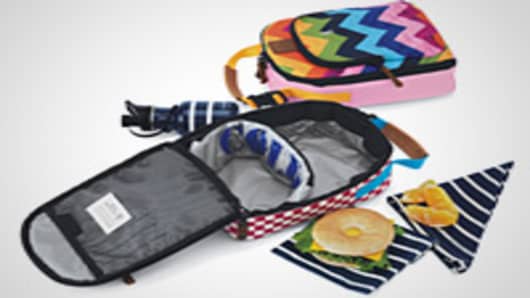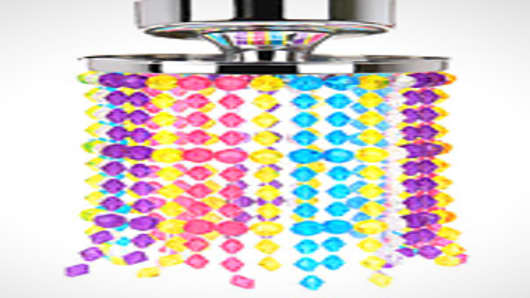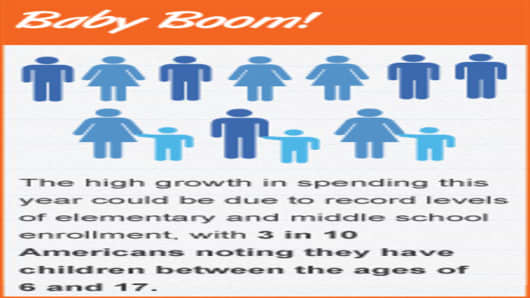As kids head back-to-school, parents focus on replenishing and replacing kids’ gear, but this year even the basics have gotten more complicated, creating a new nightmare for parents.
Backpacks have more personality. Jeans have more color. Bring a brown paper lunch bag to school? Never! What would the other students think?
Even uniforms aren’t as simple as manufacturers offer up blouses with more tailored silhouettes, skirts with more embellishments, and clothing with high-tech wicking material more commonly associated with sporting goods companies such as Nike orUnder Armour.
Perhaps that’s why many of the more recent forecastsare projecting strong gains in back-to-school spending. A survey commissioned by the retail industry’s trade group, the National Retail Federation, for example, found that the average person with children in kindergarten through high school expects to spend $688.62 for back-to-school, up from $603.63 last year.
Add in spending by college students, and the back-to-school season could ring up $83.8 billion in retail sales, the NRF says, making it the second most important spending season for retailers after the winter holidays.
“Consumers are opening up their purse strings,” said Marshal Cohen, chief industry analyst at market researcher NPD Group. He expects to see a little indulgence as parents shop for back-to-school items.
“The good news this year is they plan on listening to their kids and getting some of the things their kids want to buy,” Cohen said. “When kids are going to get to buy what they want to buy, that’s a good sign.”
Bolder Backpacks
Take the backpack. It’s often the first item people buy for back-to-school. This year, kids are buying backpacks that really make a statement and stand out in the crowd.
Lands' End, a unit of Sears Holdings , expanded its selection of prints and patterns to take advantage of the trend. The company also expanded the number of reusable lunch boxes and accessories it offers, and many of these items coordinate with the backpack designs.
Parents have been buying insulated lunch boxes and water bottles for food safety reasons. But this year reducing waste, like baggies and plastic forks, is the target. So Lands' End added resuable sandwich wraps, napkins and utensils, to its line-up.
But backpacks and lunch boxes also are a way for kids to express themselves — this becomes especially important as more schools require uniforms or a standard dress code, said Adam Weil, senior director of Lands' End School, which oversees the retailer's uniform division.
Shift to Uniforms Still Growing
The shift to uniforms, even at public schools, has continued over the past few years, and the numbers are surprising. Twenty-three percent of all public and private schools in the U.S. now have a uniform policy, with public schools making-up the majority at 19 percent, according to the National Center for Education Statistics. New Orleans, Cleveland, Chicago, Boston, Miami and Cincinnati all have the majority of their public schools requiring uniforms. The newer twist with the trend is that even children in preschool are being asked to adhere to a dress code.
French Toast, a leader in the school uniform business, expects its sales to rise at least 10 percent this year — the best performance since before the recession.
Also, more broadly, there is an increase in elementary- and middle-school enrollment. According to the NRF, three in 10 Americans have children between the ages of six-years-old and 17-years-old. More kids likely will mean more back-to-school spending.
NPD’s Cohen expects kids will want to splurge on new fashions. For girls, this means colorful pants and clothing with a more feminine look. Boys will likely opt for dressier styles this year. Cohen also expects to see higher spending on footwear, especially athletic shoes. And athletic gear will get a boost from the back-to-school spending spree.
And even uniforms from French Toast andLand’s Endare more style conscious this year.
"We bring in the fashion elements without overstepping how school uniforms should look," said Michael Arking, president of FrenchToast.com. "We don't get so far from what a uniform is in terms of modesty." This may mean details such as double-ruching on a girls' blouse, more elaborate button treatments, or a more fitted silhouette.
But whether parents are shopping for uniforms or not, some experts expect some spending may be delayed until it gets closer to the start of the school year and until the temperatures drop.
“No one wants to buy a wool sweater when it’s hot out,” Cohen said. He expects there will be waves of sales growth. “In the early stages, school supplies and electronics will do well. And when school is back in session apparel and footwear will show some true promise, driving shoppers to department, sporting goods, and specialty stores."
While some suspect the delay in spending is driven by a desire to seek out the best promotions or to spread out spending, promotions aren’t the only things shoppers are after this year, according to Wendy Liebmann, CEO of WSL/Strategic Retail.
“Price doesn’t go away,” Liebmann said. “It’s almost the price of entry, having a good value.”
But other factors are part of the equation, including convenience. In a survey of 410 adults in June, only 26 percent said they were selecting a store based on it having the best back-to-school promotions. Instead, parents are looking for convenience.
Longer Supply Lists
Since many parents are looking for a one-stop shopping solution, it may not be surprising that some three-quarters of those polled by WSL/Strategic Retail plan to head to discounters such as Target, Wal-Martand Kmart.
And what’s on their shopping list might surprise you. Sure there are the usual pencils, notebooks, jeans and sneakers, but Liebmann expects many of the back-to-school shoppers to stock up on health-related products such as healthy snacks (50 percent) and anti-bacterial items (38 percent).
The longer shopping lists also may be a factor that explains why many parents are expecting that they will spend more this year. Schools are asking parents to buy a lot of supplies they once provided. Plus, many consumer packaged goods companies are trying to grab their own piece of the back-to-school spending spree.
Hitching a Ride
“Parents have to open their wallets during this season,” Liebmann said. “You do have to spend something to get your kids back-to-school….companies are trying to hitch a ride.”
The Wish Factory, a toymaker, is a good example. This year the company has launched Locker Rockers, a line of school locker accessories priced between $5 and $20 each, at Toys ‘R Us stores. The items range from little chandeliers to light up a locker to decorative mirrors, wall paper and hangers for storing headsets. Even the bottom of the locker hasn’t been forgotten – there are shaggy rugs to jazz that up.
“A girls’ room at school is the locker,” said Scott Bachrach, president of the Wish Factory. Locker Rockers helps a girl “express who she is."
The product has been on the shelves for six weeks, and so far “sales are very good,” Bachrach said. He expects it will be a growing category.
Certainly, locker accessories are not a necessity, so it supports the theory that parents will let kids make some discretionary purchases.
Doubts Remain
Still, there are some who are less certain that these rosy forecasts will come to fruition.
Ron Friedman, retail practice leader at consulting and accounting firm Marcum, doesn’t doubt that there is consumer demand and the desire for these products. However, he has looked at months of weakening consumer confidence and consumer spending levels, and he expects consumers will be cautious. What’s more, retailers have a high hurdle to jump to top last year’s strong back-to-school sales.
“Teenagers are pulling back, kids are going to have to make do with less, parents are being very selective,” Friedman said.
According to Friedman, wealthier consumers have the money to spend and they may continue to buy $60 T-shirts for their children, but the majority of Americans will spend cautiously until at least the presidential electionthis fall. What’s more, visits to Southern California stores, where schools open in mid-August, have not shown a frenzy of buying, Friedman said.
If Friedman is right, it may be back to basics for students after all.
Questions? Comments? Email us at consumernation@cnbc.com. Follow Christina Cheddar Berk on Twitter @ccheddarberk.


